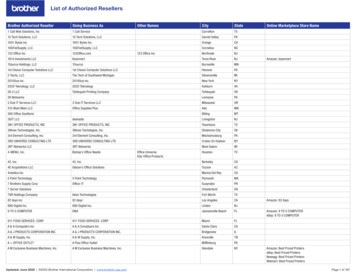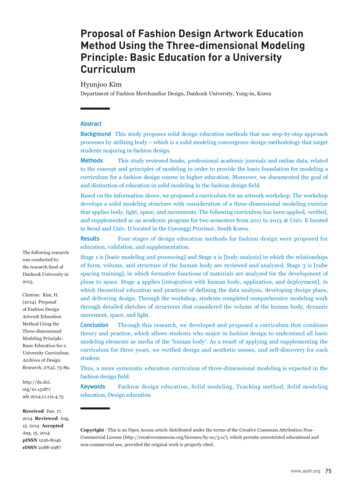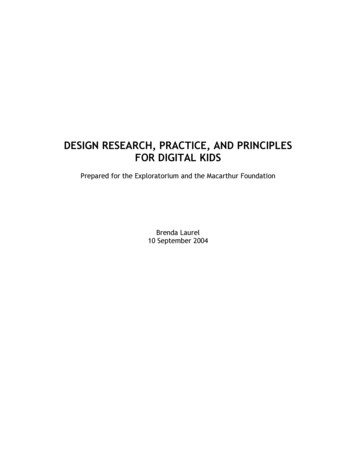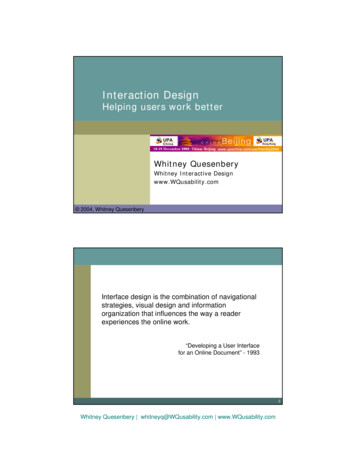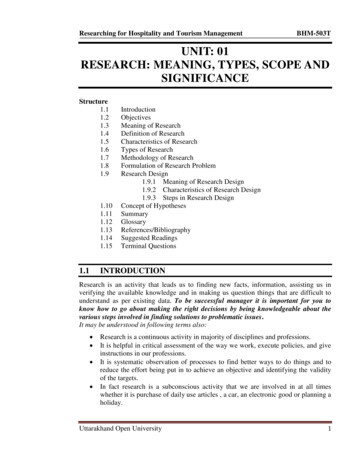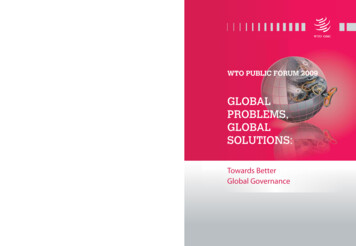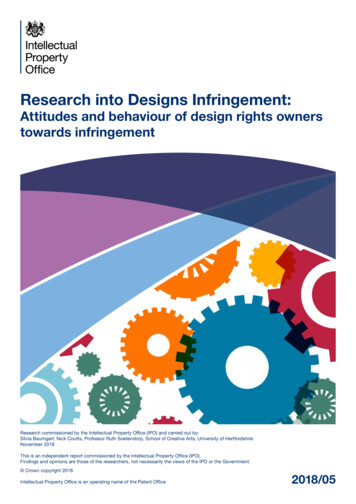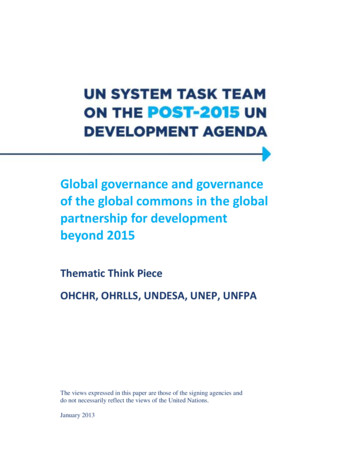
Transcription
Design Research Education andGlobal ConcernsDanielle WildeKeywordsAbstractPost-disciplinarityIf the ecosystems that we are part of and rely on are to flourish, we mustAnticipationurgently transform how we live, and how we imagine living. Design educa-Capacity-buildingtion has a critical role to play in this transformation, as design is a materiallyGlobal challengesengaged, world-building activity. Design is complicit in the problems we areResearch educationfacing, and informs and shapes how people live. In this article, I seed ideasTransformative designabout design research education for global challenges. I speak to the meritsof post-disciplinary and hybrid strategies, and look to science for clues abouthow to respond to twenty-first-century challenges through design. I positReceivedsustainability brokering as a new pathway for design, and anticipating al-October 31, 2019ternative futures as a critical step in developing transformative innovation. IAcceptedthen propose participatory research through design as a foundational meth-May 5, 2020odology; describe four pillars of practice to scaffold sophisticated researchat undergraduate and master’s level; and lay out a work plan for buildingresearch capacity in a doctoral school. Through this process, I articulate coreDANIELLE WILDEskills that design researchers will likely require if they are to contribute toDepartment of Design and Communication,global challenges constructively. My aim is to seed fruitful regenerative dis-University of Southern Denmark, Denmark(corresponding author)cussion with these propositions.d@daniellewilde.comCopyright 2020, Tongji University and Tongji University Press.Publishing services by Elsevier B.V. This is an open access article under the CC BY-NC-ND nd/4.0/).Peer review under responsibility of Tongji University and Tongji University doi.org/10.1016/j.sheji.2020.05.003
1711 IPCC, “Global Warming of 1.5 C,” specialreport from IPCC, 2018, accessed May 18,2020, http://www.ipcc.ch/report/sr15/;IPCC, “Special Report on Climate Changeand Land,” special report from IPCC, 2020,accessed May 18, 2020, https://www.ipcc.ch/srccl/; IPBES, “Introducing IPBES’ 2019Global Assessment Report on Biodiversityand Ecosystem Services,” The Intergovernmental Science-Policy Platform on Biodiversity and Ecosystem Services, May 2019,accessed May 18, 2020, -preview; Walter Willett et al., “Food in theAnthropocene: The EAT–Lancet Commissionon Healthy Diets from Sustainable FoodSystems,” The Lancet 393, no. 10170 (2019):447–92, DOI: https://doi.org/10.1016/S01406736(18)31788-4; Independent Group ofScientists appointed by the Secretary- General, Global Sustainable DevelopmentReport 2019: The Future Is Now — Science forAchieving Sustainable Development (NewYork: United Nations, 2019), http://sustainabledevelopment.un.org.2 Christiana Figueres and Tom Rivett-Carnac,The Future We Choose: Surviving the ClimateCrisis (London, UK: Manilla Press, 2020);Ann Light, Irina Shklovski, and AlisonPowell, “Design for Existential Crisis,”in CHI Conference Extended Abstracts onHuman Factors in Computing Systems(New York: ACM, 2017), 722–34, https://doi.org/10.1145/3027063.3052760; ArturoEscobar, Designs for the Pluriverse: RadicalInterdependence, Autonomy, and the Makingof Worlds (Durham, NC: Duke UniversityPress, 2018).3 Victor Papanek, Design for the Real World:Human Ecology and Social Change (Thamesand Hudson London, 1972).4 Tomás Maldonado, Design, Nature, and Revolution: Toward a Critical Ecology (Minneapolis, MN: University of Minnesota Press,2019 [1972]); Papanek, Design for the RealWorld; Thomas T. K. Zeung, ed., BuckminsterFuller: Anthology for the New Millennium(New York: Macmillan, 2001); Tony Fry, ANew Design Philosophy: An Introduction toDefuturing (Sydney: UNSW Press, 1999);Tony Fry, Design Futuring: SustainabilitymEthics and New Practice (Sydney: UNSWPress, 2009), 71–77; Tony Fry, Design asPolitics (Oxford: Berg Publishers, 2010); EzioManzini, Design, When Everybody Designs:An Introduction to Design for Social Innovation (Cambridge, MA: MIT Press, 2015);Light et al., “Design for Existential Crisis”;Escobar, Designs for the Pluriverse.5 Melissa Leach et al., “Transforming Innovation for Sustainability,” Ecology andSociety 17, no. 2 (2012): 11, DOI: https://doi.org/10.5751/ES-04933-170211.Wilde: Design Research Education and Global ConcernsIntroductionWith increasing urgency, global and intergovernmental reports inform usthat we must transform how we live if human society and the planetaryecosystem that we are both part of and rely on are to flourish.1 Such transformation requires radical shifts in the beliefs, attitudes, values, and systemsthat guide, shape, and constrain our behaviors. It requires culture change,in society broadly, but also in design education, as design shapes our world.Humans — impactful species that we are — must become more mindful ofhow intertwined we are with nature, and with each other across the globe,and the broad-reaching impact of our situated (material, social, cultural,political, and ecological) practices. We need to make room for more diversestories — a plurality of experiences and perspectives — and start choosingvibrant, regenerative futures that consider diverse, more-than-human concerns.2 Design education is necessarily a part of this transformation. Designand designers have contributed in profound ways to the problems we face,and continue to shape our world. For design to contribute constructively,design education must be continually renewed. Rather than “teachingskills related to processes and working methods of an age that has ended,”3we need to teach for the inherent instability of the circumstances at hand.We need to equip designers to respond not only to urgent crises such asCOVID-19, climate change, ecosystem collapse, social and environmentalinjustices, war, mass migration, poverty, food scarcity, and more; but alsoto as-yet- unknown possibilities. This is not a new story. For decades, Tomás Maldonado, Victor Papanek, Buckminster Fuller, Tony Fry, Ezio Manzini,Ann Light and her colleagues, Eli Blevis, Arturo Escobar, and more have beentelling this story.4 And yet, it still urgently requires our attentiveness and care.In this article, I focus on design research education for global challenges.I make a series of propositions: taking a post-disciplinary approach, usinghybrid strategies, and looking to science and creativity for clues about howdesign research education might become fit for twenty-first-century challenges. I posit sustainability brokering — a proposition of resilience andsustainability studies to transform innovation for sustainability5 — as a newpathway for design. From this vantage point, I outline the value of anticipation if we want to develop radically different ways of living — more sustainable, nourishing, and regenerative. I then lay out the practices and principlesthat guide my design research pedagogy. I describe a participatory, appliedaction-reflection approach to research-through-design plus four pillars ofpractice that I find essential for designers to contribute to transformationalinnovation. These can scaffold sophisticated research at the undergraduateand master’s level. I then describe a work plan for building research capacityin an art and design doctoral school. This process results in a list of core skillsthat (I believe) design researchers require if they are to contribute to globalchallenges constructively.The ideas I present are not new. However, I find that they are not alwayssuccessfully disseminated or assimilated into practice, and when introduced to fledgling design researchers, these approaches often prove gamechangers. Further, my understanding of their value has become more pointedduring the COVID-19 pandemic (unfolding as I write), as design students
1726 John Dewey, Art as Experience (New York:Penguin Group, 2005); John Dewey, “Democracy in Education,” The ElementarySchool Teacher 4, no. 4 (1903): 193–204,available at 086/453309;John Dewey, The Public and Its Problems:An Essay in Political Inquiry (New York:Holt, 1927).7 Jane Addams, Democracy and SocialEthics (Chicago: University of IllinoisPress, 2002).8 George Herbert Mead, Mind, Self andSociety, vol. 111 (Chicago: University ofChicago Press, 1934).9 Paulo Freire, Pedagogy of the Oppressed,trans. Myra Bergman Macedo (New York:Bloomsbury Academic, 2000), 36.10 Jutta Weber, “From Science and Technology to Feminist Technoscience,”in Handbook of Gender and Women’sStudies, ed. Kathy Davis, Mary Evans,and Judith Lorber (London: SagePublication, 2006), 397–414; AstridaNeimanis, Cecilia Åsberg, and JohanHedrén, “Four Problems, Four Directionsfor Environmental Humanities: TowardCritical Posthumanities for the Anthropocene,” Ethics & the Environment 20,no. 1 (2015): 67–97, DOI: https://doi.org/10.2979/ethicsenviro.20.1.67; MariaPuig de la Bellacasa, Matters of Care,Speculative Ethics in More Than HumanWorlds (Minneapolis, MN: University ofMinnesota Press, 2017).she ji The Journal of Design, Economics, and InnovationVol. 6, No. 2, Summer 2020and researchers lose access to the workshops and facilities integral to ourpractice. I hope that juxtaposing and articulating them from my particularperspective serves to refresh them, and thereby bring them in new ways tothe consideration of the design community.As a design researcher and educator, my praxis is informed by A mericanpragmatism — Dewey’s active inquiry, expansive aesthetics, and problem- centered pedagogy;6 Jane Addams’s pragmatism in action: relationality,contextualization, diversity, and ethics of care;7 George Herbert Mead’sperspectives on relations between self and community.8 It also leans onBrazilian educator and philosopher Paolo Freire’s commitment to praxis astheory in action — combining creative reflection and thoughtful action totransform the world;9 and feminist philosophies — a critical commitment toself-reflexivity, contextuality of knowledge, and (more-than-human) empowerment.10 My stance is research-oriented and practically informed.I teach and supervise into second and third cycle (master’s and PhD) designresearch programs in Scandinavia and elsewhere, and make occasionalforays into undergraduate education, using the same research-orientedmethods. My primary areas of expertise are embodied design, and participatory, speculative, and critical research-through-design. I have an unconventional education — I transitioned from professional practice into a designmaster’s program; I hold a PhD but do not have an undergraduate degree.My professional experience includes live art, working with food and developing policy advice. From these divergent perspectives, I reflect on whatresearch-oriented design students might expect of the academy, what theworld might need from design, and thus what I, as a design research educator need to deliver. I begin with post-disciplinarity.11 Nina Lykke, Feminist Studies: A Guide toIntersectional Theory, Methodology andWriting (New York: Routledge, 2011), 18.12 Donna Jeanne Haraway, The HarawayReader (New York: Routledge, 2004), 335.13 Lykke, Feminist Studies, 19.Post-DisciplinarityFeminist studies scholar Nina Lykke explains that while her field can be interpreted as an independent field of knowledge production, it “should claimits innovative force and academic authority in contrast to traditional disciplinarily specialized ways of organizing scholarly knowledge;” and “keep alivethe tension that is embedded in defining itself both as a field of knowledgeproduction in its own right and as a field characterized by a total opennessto transversal dialogues, crossing all disciplinary boundaries.”11 This doublestance is what makes Feminist Studies a post-disciplinary discipline (or postdiscipline). I suggest her reasoning can be applied word for word to designresearch, to the benefit of the field. From this perspective, design researchrenegotiates not only the content of science and knowledge production, butalso what Donna Haraway calls its thinking technologies,12 including its“modes of working and organizing, critically posing questions such as, ‘Whatkind of phenomena are science and scholarly knowledge production? Howshould they be carried out to reach good results? What is a good result? Whatdoes it mean to work and write in a scholarly way? Which kinds of organizational structures give the optimal basis for reaching good results’?”13
17314 Doreen Massey, “Negotiating DisciplinaryBoundaries,” Current Sociology 47, no. 4(1999): 5–12, DOI: https://doi.org/10.1177/0011392199047004003; Stephen EdelstonToulmin, Return to Reason (Cambridge,MA: Harvard University Press, 2009);Tomas Hellström, Merle Jacob, and SørenBarlebo Wenneberg, “The ‘Discipline’ ofPost-Academic Science: Reconstructing theParadigmatic Foundations of a Virtual Research Institute,” Science and Public Policy30, no. 4 (2003): 251–60, DOI: https://doi.org/10.3152/147154303781780407.15 Alan Blackwell et al., “Creating Valueacross Boundaries: Maximising the Returnfrom Interdisciplinary Innovation” (research report, UK National Endowment forScience, Technology and the Arts, g value across boundaries.pdf.16 Michael Gibbons, The New Productionof Knowledge: The Dynamics of Scienceand Research in Contemporary Societies(London: Sage, 1994).17 Tim Coles, C. Michael Hall, and DavidTimothy Duval, “Tourism and Post- Disciplinary Enquiry,” Current Issues inTourism 9, no. 4–5 (2006): 293–319, DOI:https://doi.org/10.2167/cit327.0.18 Michael W. Meyer and Don Norman,“Changing Design Education for the 21stCentury,” She Ji: The Journal of Design,Economics, and Innovation 6, no. 1(2020): 18, DOI: https://doi.org/10.1016/j.sheji.2019.12.002.19 Johan Rockström et al., “A Safe Operating Space for Humanity,” Nature 461,no. 7263 (2009): 472, DOI: https://doi.org/10.1038/461472a.20 Leach et al., “Transforming Innovationfor Sustainability,” 11; Will Steffen et al.,“Planetary Boundaries: Guiding HumanDevelopment on a Changing Planet,”Science 347, no. 6223 (2015): 1259855, DOI:Wilde: Design Research Education and Global ConcernsA post-disciplinary stance recognizes that in many contexts, clear-cut categories and separation of disciplines is no longer useful or viable. Indeed,when disciplinary concerns dominate, salient issues may be rendered invisible.14 So while disciplines per se are not abandoned, a post-disciplinaryresearcher tries to remain vigilant to their limitations, and in doing so,test their boundaries and contribute to their growth. This approach runscounter to the interdisciplinary approach to innovation that brings togetherknowledge from different research disciplines to generate ideas.15 It offersan emergent and responsive approach to complex, contemporary issues inways that transgress disciplinary — and other siloed — ways of thinking.When taking a post-disciplinary approach to applied research, knowledgeemerges from the context of application with “distinct theoretical structures,research methods and modes of practice which may not be locatable on theprevailing disciplinary map.”16 This stance enables researchers to respondto the situated concerns at hand. Post-disciplinarity is routine in public andprivate sector consultancy, for example in the service industries.17 Bringingthis mindset into a university structure enables researchers, educators, andstudents to bring divergent perspectives to a context of concern, convergeexisting approaches, and invent new ones in response to emergent issues.Design research is at once multifaceted, theoretically engaged, and applied. These characteristics position it ideally to embrace post- disciplinarityas a pathway to move beyond siloed understandings of problems, and cocreate, with stakeholders, radically new ways of responding to challengesand concerns. When designers understand “how to use the specializedknowledge of all the different disciplines involved in [a] task in a way thatbest produces a positive outcome”18 they can support themselves, theirteam, and others to reinvigorate how we approach wicked problems andgrand societal challenges. A post-disciplinary stance can assist designersin evolving their practice and step up to challenges in ways that are at onceempowered and empowering.—Takeaway: Skill in post-disciplinary practice will benefit designers who wishto engage with wicked problems and global .21 John M. Drake and Blaine D. Griffen, “EarlyWarning Signals of Extinction in Deteriorating Environments,” Nature 467, no. 7314(2010): 456, DOI: https://doi.org/10.1038/nature09389; IPCC, “Global Warming of1.5 C”; Wenyuan Fan et al., “Stormquakes,”Geophysical Research Letters 46, no.22 (2019): 12909–18, DOI: https://doi.org/10.1029/2019GL084217.22 IPCC, “Global Warming of 1.5 C.”23 The other three are performance challenges, systemic challenges, and contextualchallenges. See Ken Friedman, “DesignEducation Today — Challenges, Opportunities, Failures,” Academia, October 3, 2019,https://www.academia.edu/40519668.24 Meyer and Norman, “Changing DesignEducation,” 16.The Grandest Challenge?In 2009, Johan Rockström and his colleagues19 identified nine planetaryboundaries, beyond which we risk triggering earth system tipping points,uncontrollable ecosystem feedback loops, and an unsafe operating spacefor humans. We have long transgressed several of these global thresholds,20and as a result are experiencing more extreme and complex weather eventsand accelerating species extinctions.21 With business as usual, we mightexpect increasingly catastrophic outcomes.22 This problem is a globalchallenge — one of four challenges for design education identified by KenFriedman23 — and is currently not well covered by design education.24And yet, it touches every material interaction that humans enact. To takea single, potent example: the human food system pressures all nine planetary boundaries and affects all seventeen of the UN World Sustainability
17425 United Nations, “About the Sustainable Development Goals,” accessedOctober 31, 2019, ble-development-goals/.26 Willett et al., “Food in the Anthropocene”;For additional examples, see Future Earth,“The Future Earth Initiative,” FutureEarth,accessed April 15, 2020, https://futureearth.org/.27 Jeffrey D. Sachs et al., “Six Transformationsto Achieve the Sustainable DevelopmentGoals,” Nature Sustainability 2 (2019):805–14, DOI: https://doi.org/10.1038/s41893-019-0352-9; Figueres andRivett-Carnac, The Future We Choose.28 Tabitha Carvan, “How Do We Go On?,” ANUScience, Health & Medicine, 2019, accessedMay 18, 2020, -we-go; Figueresand Rivett-Carnac, The Future We Choose.29 Elizabeth Shove, “Beyond the ABC:Climate Change Policy and Theories ofSocial Change,” Environment and PlanningA: Economy and Space 42, no. 6 (2010):1273–85, DOI: https://doi.org/10.1068/a42282.30 Ann Light, “Talking about CollaborativeEconomies: Platforms, Trust and Ethnographic Methods, Keynote Talk,” inEthnographies of Collaborative EconomiesConference Proceedings, ed. P. Travlou andL. Ciolfi (University of Edinburgh, October25, 2019), paper no. 17, available at es/Paper17%20Light.pdf; Figueres andRivett-Carnac, The Future We Choose.31 Ezio Manzini, “New Design Knowledge,”Design Studies 30, no. 1 (2009): 6, https://doi.org/10.1016/j.destud.2008.10.001.32 Melissa Leach, Kate Raworth, and JohanRockström, “Between Social and PlanetaryBoundaries,” in ISSC/UNESCO, World SocialScience Report 2013: Changing GlobalEnvironments (Paris: OECD publishing andshe ji The Journal of Design, Economics, and InnovationVol. 6, No. 2, Summer 2020Development Goals (SDGs).25 Humans must eat — eating is a biologicalnecessity and essential socio- cultural practice. Yet our current food systemis making both people and planet sick.26 Fortunately, if the science is right,it is not too late to reverse this trend.27 We need to reconnect our everydayactions and our development pathways with the biosphere’s capacity to sustain them. Experts tell us that this challenge is neither a science problem nora technology problem — it is a problem with our sociopolitical values.28 Weneed social change29 to shift the beliefs, attitudes, values, and societal structures that drive our behaviors; to rebuild our cultures from the bottom up;and to develop new models for living.30 How to make this shift is an intricatedesign problem; to address it we need to be educating designers and designresearchers, positioning it as both background and foreground for everysingle design action. As Manzini eloquently stresses, “These changes requiredesigners to rethink themselves, to rethink how they operate and reshapetheir position in society.”31 I propose that they require designers to forge newkinds of collaborative partnerships and engage with new kinds of knowledgein an ongoing, self-reflexive, regenerative process.—Takeaway: The ability to think and discuss design beyond the disciplineitself will enable designers to forge new kinds of collaborative partnershipsand engage with new kinds of knowledge, in an ongoing, self-reflexive,regenerative process; this will enable designers to continually renew ourdiscipline towards locally situated, globally sensitive impact.—In 2013, Melissa Leach, Kate Raworth, and Johan Rockström32 mapped outsocial and planetary boundaries, to delineate an alternative, just pathwayfor sustainable development.“Just as there are planetary boundaries beyond which lies environmental degradation that is dangerous for humanity, so too there are social boundariesbelow which lie resource deprivations that endanger human well-being .Combining the inner limits of social boundaries and the outer limits ofplanetary boundaries creates a doughnut-shaped space within which allof humanity can thrive by pursuing a range of possible pathways that coulddeliver inclusive and sustainable development.” (Figures 1–3).UNESCO Publishing, 2013), 84–89, ing on: Kate Raworth, A Safe and JustSpace for Humanity: Can We Live withinthe Doughnut? (UK: Oxfam, 2012), -the-doughnut-210490.33 Leach at al., “Between Social and PlanetaryBoundaries,” 85.34 Eduardo Gudynas, “Is Doughnut EconomicsToo Western? Critique from a Latin AmericanEnvironmentalist,” Oxfam, February 15, doughnut-economics-too-western/.35 Björn-Ola Linnér and Henrik Selin,“COCOYOC DECLARATION: How It All Began:Global Efforts on Sustainable DevelopmentTheir framework clarifies one of humanity’s major challenges: ensuring“that the use of Earth’s resources achieves the human rights of all . whilesimultaneously ensuring that the total pressure on Earth systems remainswithin planetary boundaries.”33 This model is not without critics. LatinAmerican environmentalist Eduardo Gudynas,34 cautions we cannot forgetthe long tradition of debates on development and the environment,35 noruncritically adopt Western concepts of development. We must break withanthropocentric ethics and acknowledge the rights of nature. In the newethic, rather than separating environmental and social components, somewould be contained within others. We need non-Western voices, to makesuch shifts.Building on this research, the Digital Revolution and Sustainable Development: Opportunities and Challenges36 report details six transformations
Wilde: Design Research Education and Global ConcernsclimatechangeFigure 1Raworth’s “Doughnut Diagram.” Betweenozdenvironmentally safe and socially just spaceECin which humanity can thrive. Source: Katetheto Think like a 21st-Century Economist (WhitePublishing.just space forndhumeafL FOUNDATIaONsa SOCIAwaterfoodSHincome& workhousinggenderequalitypeace &justiceGERMYpoliticalvoiceOREys iterdiv sbio lossocialequityATIVIVEE AND DIS TRIB UTECONrate lshwfres rawadwithco landnversionFigure 2overshoot in the ecological ceiling (illustrat-Beyond the boundaryBoundary not quantifiedclimatechangeed by red wedges). Source: Kate Raworth, “ADoughnut for the Anthropocene: Humanity’sPlanetary Health 1, no. 2 (2017): e48. LicensedenefoodL FOUNDATInetworksair pollutionC IAheaONLALTFORSHh o usicom/doughnut/.SOnge ueqst c eic &engsierdiv sbio lo styal d e rit ysoequci ialtyc o lan dnversionFigure 3Possibilities within the safe and just spacefor humanity. Source: Melissa Leach, KateRaworth, and Johan Rockström, “BetweenSocial and Planetary Boundaries,” in ISSC/UNESCO, World Social Science Report 2013:Changing Global Environments (Paris: OECDpublishing and UNESCO Publishing, 2013), 87.Licensed under CC BY-SA 4.0.c alp o l i t ic ev oiap e juterw a lsfreshdrawaw it hTOOSHEROVicalchem tionpolluMay 18, 2020, https://www.kateraworth.yrgac ocid eaifi ncacationedu“What on Earth Is the Doughnut,” accessederwatlthunder CC BY 4.0. An interactive version ofthis model can be found at Kate Raworth,Eozde oCompass in the 21st Century,” The onne letipin c o& w meorkho ns p it r oho geru n &sloadin gShortfalls in the social foundation andTOOSHEROVLALTFOR educationnetworksENac ocid eaifi ncathealthenergyair pollution2017), 38. Image courtesy of Chelsea GreenGicalchem ntiopolluRiver Junction, VT: Chelsea Green Publishing,G I CAL CEI L INtyniRaworth, Doughnut Economics: Seven WaysOLOnioryelae tionneo plethe social and planetary boundaries lies anph nos itrph ogeor n &usloading175p
176from Stockholm to Rio” (Presented at theshe ji The Journal of Design, Economics, and InnovationTable 16th Nordic Conference on EnvironmentalSocial Sciences, Åbo, Finland, June 12–14,Vol. 6, No. 2, Summer 2020Six transformations necessary to alter our trajectory towards humanand planetary flourishing, considering the impacts of our actions onthe UN Sustainability Development Goals (SDGs).2003), also available at Cambridge Forecast Group Blog (blog), December 3, on, Gender, and Inequality.Involving ministries of education, science and technology, gender equality and family affairs,this transformation covers investments in education (early childhood development, primaryand secondary education, vocational training and higher education), social protection systemsand labor standards, and R&D. It directly targets SDGs 1, 2, 4, 5, 8, 9, and 10, and reinforcesother SDG outcomes.2.Health, Wellbeing, and Demography.Group interventions to ensure Universal Health Coverage (UHC), promote healthy behaviors,and address social determinants of health and wellbeing. It directly targets SDGs 2, 3, and 5with strong synergies into many other goals. Implementation will need to be led by ministriesof health.3.Energy Decarbonization and Sustainable Industry.This transformation groups investments in energy access; the decarbonization of power, transport, buildings, and industry; and curbing industrial pollution. It directly targets SDGs 3, 6, 7,9, 11–15, and reinforces several other goals. Implementation will require coordination across alarge number of industries, including energy, transport, buildings, and environment.4.Sustainable Food, Land, Water, and Oceans.Interventions to make food and other agricultural or forest production systems more productive and resilient to climate change must be coordinated with efforts to conserve and restorebiodiversity; and interventions to promote healthy diets alongside major reductions in foodwaste and losses. Important trade-offs exist between these interventions, so we recommendidentifying and addressing them inside one transformation, which will need to mobilize abroad range of ministries, such as agriculture, forestry, environment, natural resources, andhealth. This broad transformation directly promotes SDGs 2, 3, 6, and 12–15. Many other SDGsare reinforced by these investments.5.Sustainable Cities and Communities.Cities, towns, and other communities require integrated investments in infrastructure, urbanservices, as well as resilience to climate change. These interventions target of course SDG 11and they also contribute directly to goals 6, 9, and 11. Indirectly virtually all SDGs are supported by this transformation, which relies on leadership from the ministries of transport, urbandevelopment, and water resources.6.Harnessing the Digital Revolution for Sustainable Development.If managed well, digital technologies, such as artificial intelligence and modern communicationtechnologies can make major contributions towards virtually all SDGs.com/2006/12/03/cocoyoc-declaration/.36 TWI2050 — The World in 2050, TheDigital Revolution and Sustainable Development: Opportunities and Challenges(Laxenburg, Austria: Laxenburg, IIASA,2019), DOI: https://doi.org/10.22022/TNT/05-2019.15913.–37 Sachs et al., “Six Transformations toAchieve the Sustainable DevelopmentGoals.”38 Gudynas, “Is Doughnut Economics TooWestern?”39 Daniel Hausknost, “Tackling the PoliticalEconomy of Transformative Change,”CUSP (blog), November 21, formative-change/.40 Tim Jackson, Prosperity without Growth:Foundations for the Economy of Tomorrow, 2nd ed. (London: Routledge, 2016).necessary to achieve dramatic improvements on the UN World SustainabilityDevelopment Goals and move us back into the safe operating space for humanity (Table 1).37 These transformations read as management and coordination issues. Yet, without widespread societal integration — broad-reachingacceptance and uptake
7 Jane Addams, Democracy and Social Ethics (Chicago: University of Illinois Press, 2002). 8 George Herbert Mead, Mind, Self and Society, vol. 111 (Chicago: University of Chicago Press, 1934). 9 Paulo Freire, Pedagogy of the Oppressed, trans. Myra Bergman Macedo (New York: Bloomsbury Academic, 2000), 36. 10 Jutta Weber, "From Science and Tech-
